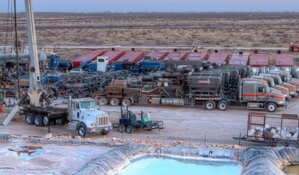Ethan Bellamy: I started out as a junior analyst covering cable and media at Stifel Nicolaus and Co. Then I got a job covering MLPs before I was lured to the buy side at Lehman Brothers, which was a shorter-lived experience than I would've hoped. I've been with Wunderlich for two years. My coverage list is a gathering of direct MLPs and closed-end MLP funds. I cover about 15 names, everything from propane to coal to the closed-end funds to oil and gas production to pipelines. I've either owned, shorted or written research on just about every MLP out there.
TER: That's quite a range of MLP experience. Ethan, we've seen about a 25% increase in dollar volume flowing into MLPs this quarter versus the same quarter last year. What's driving that increase and what sort of names are those dollars headed toward?
EB: Fund flows into MLPs can really be attributed to a bullish "perfect storm" phenomenon. First, you have the launch of two de novo MLP closed-end funds at more than $1 billion each. We also had two follow on offerings in existing MLP closed-end funds, Kayne Anderson MLP Investment Company (NYSE:KYN) and Fiduciary/Claymore MLP Opportunity Fund (NYSE:FMO), which raised another $260 million. All four of those vehicles have to rapidly put that money to work in order to pay their distributions. That's been the primary driver of fund flows into the large- and mid-cap MLPs that we've seen since mid-May. We're now coming to the end of the three-month window in which those two big initial public offerings of closed-end funds have been put to work. I wouldn't be surprised to see a short-term period of MLP underperformance as that capital deployment subsides.
The "perfect storm" is being further enhanced by the big macroeconomic trend we're seeing in U.S. Treasuries. The benchmark 10-year T-Bills just hit 2.5%. That means risk-free yields are really offering very little income, so investors are forced to look elsewhere.
We're also seeing significant fear of rising personal income tax rates for 2011 if Congress allows the Bush tax cuts to expire. With the additional taxes for "Obama Care," most people recognize that the cash from the "helicopter" stimulus plan we've had has to be paid by somebody. That somebody is going to be wage earners in the next two decades through higher taxes. On a relative basis, MLPs offer a tax-deferred income stream that looks a lot like municipal bonds; a municipal bond is tax exempt and MLPs are tax deferred until you sell. That looks pretty attractive to people considering the likelihood of higher taxes in the future.
TER: You're basically saying other investment vehicles could see more taxes, and thus it's better to be in MLPs because they likely won't be subject to the same taxes as other investments.
EB: There are taxes on MLPs but they are deferred until the time of sale; you recapture that depreciation expense upon sale. But in the interim you're getting an 80%–100% tax-deferred distribution stream, so your net present value with the investment is a lot higher.
TER: Ethan, I'm not sure most investors know the key differences between the closed-end funds and the open-end funds. Can you explain the basic differences?
EB: At the simplest level, closed-end funds are fixed pools of capital that trade on exchanges. You can have a secondary offering that will grow the pool of capital; otherwise it's fixed. You buy a share in that pool that is traded on an exchange. You can have premiums or discounts to the net asset value (NAV) of that closed-end fund based on how the shares are trading. With an open-end fund, it's a variable pool of capital that grows when you buy into it and declines when you redeem your shares. That's typically done daily through the fund manager.
In a closed-end fund you can have a discount of premium to NAV, while with an open-end vehicle you're buying or redeeming at the NAV every day. It's just basically two separate types of vehicles, both of which are popular.
TER: A couple of other MLP vehicles have launched recently. SteelPath has launched several MLP mutual funds—SteelPath MLP Alpha Fund (NYSE:MLPAX), SteelPath MLP Income Fund (NYSE:MLPDX), SteelPath MLP Select 40 Fund (NYSE:MLPFX)—and the Alerian MLP ETF (NYSE:AMLP) launched this week. Do you expect those to draw significant investment dollars away from closed-end funds?
EB: I expect less cannibalization of existing funds than new money that may like the ETF structure better for whatever reason. There's a reason no one has done an ETF in the MLP sector until now. That reason is the churn of a product like that with daily liquidity can add a tax burden.
These funds in the MLP space are different from a lot of other asset classes because they're structured as taxable investment companies that do not benefit from the same tax benefits of registered investment companies. That's intentional so that you get around the K-1 tax forms. Typically, you get 1099 tax forms by buying all these products. But you can have a tax burden. With the open-end funds and with the ETF, there's a chance that they're going to underperform the underlying index because of a tracking error created by taxes. I would encourage everyone to go read the prospectus before they go piling into the ETF thinking it's going to produce the returns that the index is likely to produce. I think it's similar to how the United States Oil Fund L.P. (NYSE:USO) or the United States Gasoline Fund, L.P. (NYSE:UGA) have underperformed the commodities that they're supposed to track, because there are specific structural features in the fund that may cause them to underperform. That might not be readily apparent to the casual observer.
With respect to the SteelPath open-end mutual funds, which are discrete and separate from the new ETF, I'm told by my industry sources that those were done on a reverse inquiry rather than on spec. Hopefully, they'll be predominantly low churn and held by registered investment advisors who are buying big positions that they'll hold for the long term. Otherwise that could create some additional volatility in the market that could be negative. For example, if there are redemptions that require the selling of a big position at the market close, that could create some volatility. Still, I think you have to hand it to Gabriel Hammond and Kenny Feng at Alerian and SteelPath for their aggressive entrepreneurialism in MLP products. They've certainly not been shy about creating an avenue for investment in the group that was unavailable to most consumers. Although I'm a fan of the closed-end funds, there are some people who are never going to be able to get over the premiums-to-GAAP NAV that some of the closed-end funds exhibit.
TER: MLP ownership seems to be transitioning from retail to institutional investors. What do you think its ultimate result will be?
EB: I think and I hope that the ultimate result will be something similar to what's occurred with Real Estate Income Trusts (REITs), where as the asset class expanded and became more institutionalized, more specific management vehicles were set up to invest in the space and valuations and liquidity improved. Ultimately, it became a stalwart investment class. I think that's occurring with MLPs and it's likely to continue on an incremental basis over time.
The sea change we've seen lately is that the combination of returns and improved liquidity has made the sector too difficult to ignore. Ultimately capital is going to flow where it is best treated. MLPs certainly offer pretty significant value propositions for an investor. The other benefit is that the bigger and more entrenched the MLP sector gets, the less likely it is that something dramatic happens with the MLP tax structure. For example, no one questions the tax benefits of REITs because they are globalized, have been around for a while and the structure is in place.
TER: You like a number of closed-end MLP funds, but you also like a number of individual MLPs. Are investors best served by directly owning MLPs or owning units in a closed-end fund or a combination thereof? What's a good mix?
EB: There's something for everybody here. It really depends on whether you are deploying taxable or non-taxable funds. Meaning, are you buying in a taxable account or are you buying in an IRA or a 401K or Keogh Plan? You can buy MLPs directly in an IRA or another non-taxable account, but at certain thresholds those will generate unrelated taxable income on the income received, not necessarily on the distributions received. There is no prohibition against buying MLPs directly and holding them in an IRA. It just can present some additional taxes that may not be warranted. The most efficient thing you can do is buy MLPs directly and receive the benefits in a taxable account. But if you want to deploy capital in the MLP space and you don't want to directly track investments, and you're worried about generating unrelated taxable income, then you might want to choose a closed-end fund or an exchange-traded note (ETN), which produces a 1099 tax form. A closed-end fund basically gives you a diversified portfolio of MLPs, so you get some portfolio diversification benefits, as well.
TER: You have buy ratings on the closed-end funds Energy Income & Growth Fund (NYSE:FEN) and Tortoise North American Energy Corp. (NYSE:TYN). Tell us about those.
EB: Energy Income and Growth Fund is sub-advised by Energy Income Partners, which is led by a guy named Jim Murchie, whom I consider the Warren Buffett of MLPs. He's value biased, very conservative. Jim picked up sub-advisory of the fund before the credit crisis, reoriented the portfolio toward very conservative investments and had a very conservative cash flow payout ratio. When the credit crisis hit and most MLP managers were forced to sell assets to maintain compliance with leverage limitations, he was forced to sell less. He was able to maintain his distribution without trimming it, whereas most of his peers were forced to cut. And FEN was the first fund to raise distributions since the credit crisis.
If you're looking for a very conservative way to play MLPs, you can take advantage of Jim's strategy, which he calls "selling pickaxes to the miners."
TER: And TYN?
EB: I like that name. TYN is a little smaller and has a little more commodity price sensitivity than some of the other funds. This is one of four funds now managed by Tortoise Advisors. I like this name particularly because they've got almost 10% of their capital allocated to two upstream MLPs I like a lot—Linn Energy, LLC (NASDAQ:LINE) and EV Energy Partners, L.P. (NASDAQ:EVEP). From time to time these funds trade differently on price to NAV. We have our own proprietary method for calculating price-to-adjusted NAV, where we basically adjust the net present value of deferred tax assets and liabilities to come up with a better representation of NAV than the nominal NAV that's reported under GAAP. But generally speaking, this is one that I think has pretty good distribution growth prospects because of its commodity price sensitivity.
TER: You said you like Linn Energy and EV Energy. Why do you like those names?
EB: The upstream MLP subsector I think has the single biggest secular growth story in MLPs. LINE and EVEP are somewhat controversial vehicles. Many of the traditional MLP asset managers look askance at them because of the history of the MLP sector. The first MLP was Apache in 1981. Thereafter many of the first MLPs were oil and gas entities that were under-hedged and over-levered and ultimately failed when oil and gas prices stayed low throughout the 1980s. These new breeds of upstream MLPs, which started with LINN Energy in 2006, are better because management realized they have to retain a significant portion of cash flow in order to reinvest it. They've also hedged strongly and, more importantly, they have a huge secular growth opportunity. They're the most efficient way in terms of tax structure to hold producing oil, gas and natural gas liquids assets that don't have much development upside because you don't pay corporate entity taxation. That way you avoid the double taxation of corporate dividends. That's the case with all MLPs but, specifically, with oil and gas assets that you're basically just trying to milk over time; it's a very efficient structure. We see about $250 billion of proved, developed, producing reserves in the United States potentially flowing into these upstream MLPs over the next decade. They have the potential to be as big as the rest of the MLP sector combined.
TER: What are some other companies that stand to benefit from that transition of assets?
EB: LINE, EVEP, Legacy Reserves, L.P. (NASDAQ:LGCY), Vanguard Natural Resources, LLC (NYSE:VNR) and BreitBurn Energy Partners, L.P. (NASDAQ:BBEP) are definitely going to be able to tap into that $250 billion pool of existing assets that I talked about. The onus is really on these partnerships not to overpay for the assets. If they can buy them on the right terms, then the world is their oyster. The one caveat for investors that I would throw out there is that there is some lingering uncertainty about the liquidity and cost of commodity derivatives after the passage of the Dodd-Frank Financial Reform Bill. There's a nominal exclusion in the legislation for end-users, but the major swap dealers may still have to collateralize some of these transactions, which would raise the costs of derivatives. At this point it's still I think unclear how this is going to shake out. It's important to point out that MLPs are large users of derivatives. If something were to come out of the Dodd-Frank legislation that was draconian with respect to derivatives, it would definitely impact the MLP sector.
TER: Let's head back to some other closed-end funds you like.
EB: The other funds I like include Kayne Anderson MLP Investment, Tortoise Energy Capital Corp. (NYSE:TYY) and Tortoise Energy Infrastructure Corp. (NYSE:TYG). Basically, these should perform in line with the Tortoise MLP Index (TMLP). They are generally a good way to access the sector. You're buying predominantly the large- and mid-cap MLPs via these funds. They have reasonable expense ratios. They have a reasonable track record. We look to enter and exit these based on price to NAV.
TER: What are some individual MLP names you like besides LINE and EVEP?
EB: Just to be clear, I don't cover those. Those are owned by TYN. The two upstream MLPs that I like and follow formally are Legacy Reserves, L.P. (NASDAQ:LGCY) and Vanguard Natural Resources. I've been following Legacy since its IPO in 2007. I just took a tour of their new properties they bought in Wyoming. Their roots are in the Permian Basin in West Texas; they're based in Midland, Texas. They just squeeze as much blood from the turnip as they can when they get assets. Sometimes the assets have not been maximized either by a small producer that maybe couldn't afford an engineer, or they were an afterthought to a larger producer that had bigger development capital projects to go after. Legacy will go in and maximize an asset. They are in there buying things as small as $2 million apiece and up to $100 million plus. Last year was a bit dicey for Legacy when oil prices cratered and it looked like private equity firm Apollo Management L.P. might come in and buy them on a discounted basis. Apollo would've pulled off the best deep value trade of the year if they were able to buy Legacy. But oil prices recovered and Legacy was able to walk away from the deal. Since that time they've been able to produce more distributable cash flow, and continue their growth-through-acquisition story. I anticipate that they'll be able to restart distribution growth very soon. We have them growing their distributions by about 5% in 2011.
TER: And Vanguard?
EB: Vanguard, which also went public in 2007, really started out as an Appalachian gas producer but it has since morphed to 50/50 gas and liquids. They stood out as robust for a small cap, particularly in 2009, by having a solid hedge book that carried them through a period of very low commodity prices. You know, in my career I'd never seen a more obvious invalidation of Efficient Market Theory given Vanguard's hedge book. I basically stood up in 2009 and said: "Vanguard is really super cheap for no reason. Go buy it." It returned more than 300% in 2009 on what I would consider a march back to fair value. I don't expect to see that kind of mispricing on an asset again in my lifetime. Now it's tracked to a more reasonable valuation range. I really like it as a growth story. I think the stage is set for them to post high single-digit distribution growth via acquisitions in the next few years. Both Legacy and VNR, along with some of the other peers I mentioned earlier, should also be able to take advantage of that $250 billion shift in assets that I talked about before.
TER: Vanguard made about a 22% gain above your estimates on commodity derivatives in the last quarter, correct?
EB: Well, the main things we look at are margins and distributions. Vanguard has been tracking pretty closely to where we think cash flow and distributions are. Although GAAP earnings are certainly relevant, they're much less relevant for MLP investors because typically we're looking at non-GAAP distributable cash flow as the true benchmark for profitability.
TER: Vanguard produces oil and gas and it's hedged, but to what extent?
EB: I believe they're 80% hedged through 2011 on gas and about 50% hedged on oil through 2013.
TER: What are they hedged at in gas?
EB: They're hedged at about $8 through 2011.
TER: With gas prices around $5 that's not a bad thing. Another thing that we wanted to talk about is that a number of the MLP indexes have vastly outperformed the bond market and certainly the S&P by large margins over the last decade. A $1,000 investment in the Cushing 30 MLP Index in December 2001 would be worth almost $5,000 now, whereas the same investment in Merrill's High Yield Bond Index would be worth just under $2,000. Why is the Cushing 30 dramatically outperforming its peers?
EB: I think the best way to talk about these is to talk about all the indexes that we watch and how they differ from one another.
The three indexes that I would point investors to would be the Alerian MLP Index (NYSE:AMZ), the Tortoise MLP Index and the Cushing 30 MLP Index (NYSE:MLPX). They will tell you what the large caps are doing via the AMZ; what a typical portfolio should be doing via the TMLP; and what a high-beta aggressive growth strategy would be doing via the MLPX.
The Cushing 30 is equal weighted, so it's going to give you more pop and more beta when the smaller cap names are performing well. In an environment where MLPs are going up, you'd expect the high beta names to be going up a lot more and the MLPX to be outperforming.
TMLP is more market cap weighted like the AMZ, but it has position limits on the large caps so it's not dominated by Kinder Morgan Energy Partners, L.P. (NYSE:KMP) and Enterprise Products Partners, L.P. (NYSE:EPD) the way the Alerian MLP Index is. It looks more like what you would actually own as an investor. If an investor were to ask: "Hey what's a proxy for a reasonable MLP portfolio?" I would tell them to look at the TMLP. You've seen all these indexes move up pretty rapidly on the strength of the capital deployment from those two IPOs—north of $1 billion.
TER: Do you have some parting thoughts on the MLP sector?
EB: I think in the near term there's some risk that you'll see a reversion toward the S&P 500, but long term I think it's pretty easy to be constructive on the MLP space. I think that we're going to see an inflationary environment essentially created by fiat money and big budget deficits. I don't think there's a really easy solution for the Fed to do anything but inflate our way out of the debt that we've created. In that type of environment, an MLP should do very well over the long term. Moreover, I think there's no way around higher personal income taxes. Frankly, most investors should be buying these for the long term because that's where the real benefit is, deferring as far out into the future as possible the taxes that will be due.
Ethan Bellamy specializes in the analysis of Master Limited Partnerships. Previously, he was the director of research for the Lehman Brothers MLP Opportunity Fund where he was responsible for fundamental analysis and due diligence in public, PIPE and pre-IPO investments in natural resources. Prior to joining Lehman Brothers, Ethan was a senior analyst covering MLPs at Stifel Nicolaus where his coverage included oil and natural gas production, gathering and transportation; propane distribution; marine shipping; coal mining; and MLP-oriented closed-end funds. Ethan previously worked as a journalist for various local and national media and taught writing and journalism at the University of Colorado at Boulder for two years. He was a doctoral student focusing on energy policy at the University of Colorado at Denver, with a focus on energy infrastructure and renewable energy policy. He holds an MA from the University of Colorado at Boulder and a BA from Clemson University. Ethan is an avid snowboarder and telemark skier, and has hiked both the Pacific Crest and Appalachian National Scenic Trails in their entirety.
Want to read more exclusive Energy Report interviews like this? Sign up for our free e-newsletter, and you'll learn when new articles have been published. To see a list of recent interviews with industry analysts and commentators, visit our Expert Insights page.
DISCLOSURE:
1) Brian Sylvester of The Energy Report conducted this interview. He personally and/or his family own shares of the following companies mentioned in this interview: None.
2) The following companies mentioned in the interview are sponsors of The Energy Report or The Gold Report: Vanguard Natural Resources.
3) Ethan Bellamy: I personally and/or my family own shares of the following companies mentioned in this interview: None. I personally and/or my family am paid by the following companies mentioned in this interview: Vanguard Natural Resources, Tortoise North American Energy, Tortoise Energy Capital, Tortoise Energy Infrastructure, Legacy Reserves, Kayne Anderson and Energy Income & Growth Fund.
This investment research is provided to Wunderlich Securities, Inc. under licenses from various third-party Investment Research Providers. Please direct any questions regarding this information to the author of the article and not to the Investment Research Provider, its analysts or other representatives.
Investment Research Providers prepare research reports. The information in these reports is not personalized investment advice and is not intended as an offer or solicitation for the purchase or sale of any financial instrument. Securities, financial instruments, or strategies mentioned in these reports may not be suitable for all investors. Information and opinions regarding specific securities do not take into account individual circumstances, objectives, or needs and are not intended as recommendations of particular securities, financial instruments, or strategies. You should evaluate this report in light of your own circumstances. Opinions and estimates constitute the Investment Research Provider’s judgment as of the date of these reports and are subject to change without notice. These reports may have been made available to us before being made available to you (our client). We are solely responsible for the distribution and use of these reports.
As a recipient of Third Party research from a Wunderlich Securities representative, it is possible that the firm may be a market maker in the subject security. If you would like to see if the firm makes a market in the stock please copy and paste the following link into an internet browser to see the most recent list of stocks the firm makes markets in. http://www.wunderlichsecurities.com/sec/Market_making_Stocks.pdf
IMPORTANT NOTICES: Wunderlich accepts no liability for any errors or omissions arising as a result of transmission. Any information contained in this article is not an offer or solicitation to buy or sell any security, and while such information has been obtained from sources believed to be reliable, its accuracy is not guaranteed. Any references to the terms of executed transactions should be treated as preliminary only and subject to our formal written confirmation.
Visit The Energy Report’s MLP Insights to learn more.










































